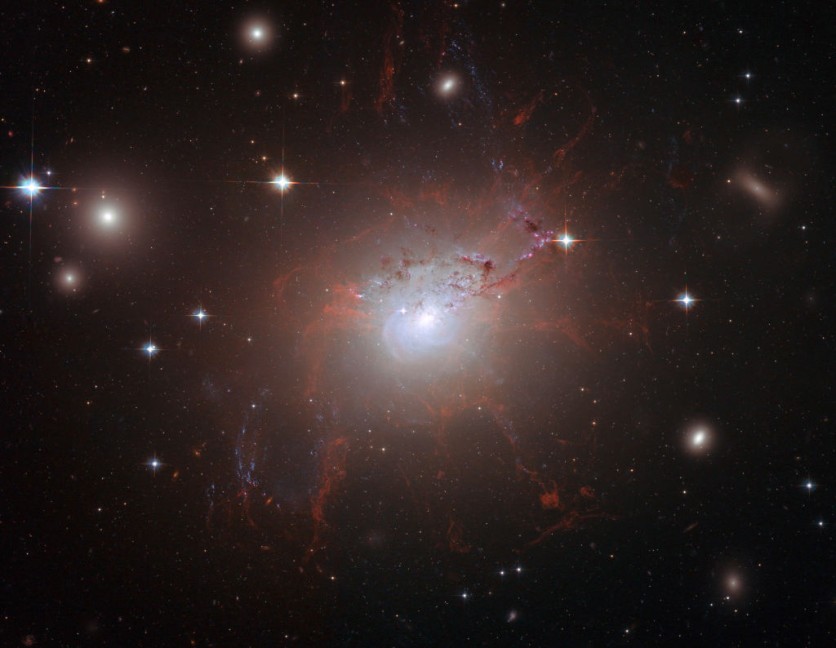
IN SAPCE - UNDATED: This handout image of the giant, active galaxy NGC 1275, obtained August 21, 2008 was taken using the NASA/ESA Hubble Space Telescope?s Advanced Camera for Surveys in July and August 2006. It provides amazing detail and resolution of fragile filamentary structures, which show up as a reddish lacy structure surrounding the central bright galaxy. These filaments are cool despite being surrounded by gas that is around 55 million ?C. They are suspended in a magnetic field which maintains their structure and demonstrates how energy from the supermassive black hole hosted at the centre of the galaxy is transferred to the surrounding gas.
Who would have thought that black holes could make sounds?
The idea that black holes are silent, lifeless voids are widely held by many. Although the first statement is true, the second is a misconception.
This holds to be true with the Perseus galaxy cluster, which has a large gas volume that allowed researchers to capture its sound. Astronomers have long associated this region with sounds since they discovered that pressure waves were sent out by the black hole and produced ripples in the cluster's hot gas.
According to NASA, this indicates that humans cannot hear some 57 octaves below middle C. However, this is now possible through NASA's sonification remix, which provides more notes to the black hole sound machine.
NASA's Exoplanets' Twitter page rereleased an audio remix of what a black hole sounds like, pointing to the Perseus galaxy cluster that the agency has recently studied.
The tweet stated that although black holes are objects that are gigantic vacuums swallowing anything from sound to light, they are not completely soundless, as has been suggested by earlier studies.
But since there is so much gas in the Perseus galaxy cluster's area, the sound was picked up and recorded and is now available as black hole audio.
Read also : New Sharp Images of the 'Biggest Star Ever Found' Reveals Strange Details About Star Masses
Sounds of Hell?
What people hear on NASA's output is eerie and ominous, and it might keep someone up at night. Black holes naturally produce haunting sounds, which NASA has only amplified so that the general public can hear and recognize the sounds produced by the space anomaly.
Although the idea of the remix is fascinating, Twitter users were startled after hearing the audio. Some of them alluded to the remix to the sound of tortured souls in hell.
Here are some of the best memes and reactions that we have gathered so far:
Me: It's late, I should probably go to bed
— Alpha Chrome Yayo (@alphachromeyayo) August 22, 2022
Also me: What if I pile a load of reverb on the NASA black hole audio and layer it with that recreated mummy voice 🤔🌌⚱️ https://t.co/y8Ri9pejbf pic.twitter.com/ozlwhrydz3
— ted cruz poodle 🪷 parody elon musk is butthurt (@TedCruzPoodle) August 22, 2022
LOLing at how a black hole sounds like a billion souls being tortured in Hell https://t.co/OBP7NVmFKj
— The Blindboy Podcast (@bbboatclub) August 22, 2022
— mkay🍥 (@manuka1811) August 21, 2022
reminded me of this amazing video pic.twitter.com/Yz6zVaXLwH
— Grumpy Dog Thing (@LazyWusky) August 22, 2022
Similar sound of that of an @F1 car? 🤔https://t.co/CBrIRycD8s
— Jesus Larios (@JesusLarios1) August 22, 2022
That’s creepier than the previous notion . As an astronaut , I’d rather hear nothing over whatever that sound is . 🫣
— TeddyRubsxkin (@TeddyRubsxkin) August 21, 2022
Weeee!
— ted cruz poodle 🪷 parody elon musk is butthurt (@TedCruzPoodle) August 22, 2022
(giggles in galaxy cluster) https://t.co/MLmvtoFis5 pic.twitter.com/xgbV0NGMmA
Related Article : NASA's Hubble Space Telescope Captures 'Orion Nebula's Dreamy Cloudscape' With Over 500 Exposures!
This article is owned by Tech Times
Written by Joaquin Victor Tacla
ⓒ 2026 TECHTIMES.com All rights reserved. Do not reproduce without permission.




